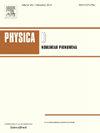New pathways to stability and instability in non-premixed Rayleigh-Taylor flames
IF 2.9
3区 数学
Q1 MATHEMATICS, APPLIED
引用次数: 0
Abstract
We report on detailed numerical simulations of a non-premixed, turbulent Rayleigh-Taylor (RT) flame, where multimode perturbations were imposed on the initial interface. In a previous article, the stability of this configuration to single-mode perturbations was investigated, which we now extend to multimode disturbances. The sharp initial interface separating the fuel and oxidizer evolved under the influence of the RT instability, while the instability-driven mixing in turn enhanced burning at the flame site. Simulations at two different Atwood numbers were performed. At an Atwood number greater than 0.5, the growth of the two layer RT flame was enhanced by bubble expansion and the additional buoyancy due to combustion. At lower Atwood numbers, burning within the flame region resulted in the formation of a third layer with a lower density than either the air or fuel streams. The behavior of the resulting three-layer RT problem depended on the direction of the applied acceleration. When the applied acceleration was such that the initial configuration was globally unstable, burning within the reaction zone resulted in the formation of an active third layer which caused the fuel-flame interface to be stable near the spikes. If the initial configuration was globally stable, burning and formation of the reaction zone resulted in a fuel-flame surface that was RT-unstable. The problem configuration and our findings are relevant to ultra compact combustors. In addition, the novel flow configuration investigated here can potentially provide a fundamentally new framework for understanding the properties of several non-premixed flames.
非预混瑞利-泰勒火焰稳定性和不稳定性的新途径
我们报告了一个非预混的湍流瑞利-泰勒(RT)火焰的详细数值模拟,其中在初始界面上施加了多模扰动。在之前的文章中,研究了这种结构对单模扰动的稳定性,现在我们将其扩展到多模扰动。在RT不稳定性的影响下形成了分离燃料和氧化剂的尖锐初始界面,而不稳定性驱动的混合反过来又增强了火焰部位的燃烧。在两个不同的阿特伍德数下进行了模拟。当Atwood数大于0.5时,气泡膨胀和燃烧产生的附加浮力促进了两层RT火焰的生长。在较低的阿特伍德数下,火焰区域内的燃烧导致密度低于空气或燃料流的第三层的形成。所得到的三层RT问题的行为取决于施加加速度的方向。当施加的加速度使初始构型全局不稳定时,反应区内的燃烧导致活性第三层的形成,这使得燃料-火焰界面在峰值附近保持稳定。如果初始构型是全局稳定的,则燃烧和反应区的形成导致燃料-火焰表面是rt不稳定的。问题配置和我们的研究结果与超紧凑型燃烧器有关。此外,本文研究的新型流动结构可能为理解几种非预混火焰的特性提供一个全新的框架。
本文章由计算机程序翻译,如有差异,请以英文原文为准。
求助全文
约1分钟内获得全文
求助全文
来源期刊

Physica D: Nonlinear Phenomena
物理-物理:数学物理
CiteScore
7.30
自引率
7.50%
发文量
213
审稿时长
65 days
期刊介绍:
Physica D (Nonlinear Phenomena) publishes research and review articles reporting on experimental and theoretical works, techniques and ideas that advance the understanding of nonlinear phenomena. Topics encompass wave motion in physical, chemical and biological systems; physical or biological phenomena governed by nonlinear field equations, including hydrodynamics and turbulence; pattern formation and cooperative phenomena; instability, bifurcations, chaos, and space-time disorder; integrable/Hamiltonian systems; asymptotic analysis and, more generally, mathematical methods for nonlinear systems.
 求助内容:
求助内容: 应助结果提醒方式:
应助结果提醒方式:


